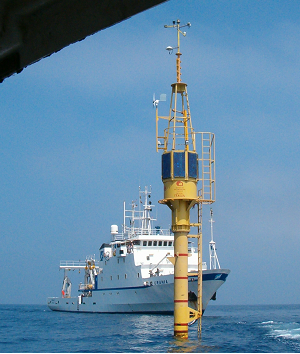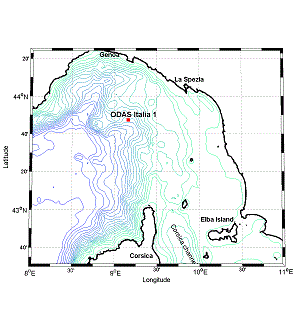Science theme
The effective management, monitoring and protection of the marine ecosystem require the use of multi-variable real-time measurements combined with advanced physical and ecological numerical modeling tools.
Fixed permanent ocean observatories can contribute significantly to operational monitoring especially when high frequency, multiple parameters and data from the sea surface down to the ocean interior and the seafloor are the requirements.

The W1M3A mooring position is at the crossroads of different commercial routes and the observatory is highly exposed to winds and waves from the Gulf of Lion as well as from the Italian seas, without any shields by the surrounding orography.
For these reasons it occupies an ideal position for collecting data about sea waves and offshore winds, for detecting the early signs of incoming bad weather, and, in general, for acquiring meaningful long time series of meteo-oceanographic parameters.

The observing system payload was designed to provide real time biochemical data of the euphotic zone euphotic zone(0-100 m) and physical parameters of the upper thermocline (0-500 m) and down to the sea bottom.
The euphotic zone is the zone of the ocean where primary productivity occurs: primary production is the production of organic compounds from carbon dioxide dissolved into the water principally through the process of photosynthesis carried out by phytoplankton.
Below the euphotic zone, the dark ocean exists: in the ocean interior the abundance of organisms and their total biomass decreases.In the euphotic zone, temperature, salinity, oxygen, fluorescence, turbidity, carbon dioxide and pH are measured by the W1M3A system whereas in the dark region only temperature and salinity are considered.
The Ligurian Sea is the more inland sea of the Mediterranean: these orographic constraints and the thermal contrast between land and sea give rise to specific local effects that influence the general circulation of both atmosphere and ocean.
It forms, with the Gulf of Lyon, the Ligurian-Provencal basin, one of the most active, dynamic and most productive site among the whole Mediterranean. In North-Western Mediterranean it is the main pit of water and heat and is therefore essential component of its energy balance.
The heat and water diverted to this basin in winter are not replenished during other seasons and this fact determines its role in atmospheric and oceanographic dynamic. It contributes to the formation of cyclogenesis : in this area more than 50% of depressions of the Mediterranean Sea occur, with effects that may cause harmful consequences in adjacent regions, such as floods in coastal Liguria and Tuscany.
In the oceanographic domain, his role is similar to the one sustained by the Adriatic Sea towards the Eastern Mediterranean. During winter, the region hosts dense water formation processes whose variability depends on the degree of oxygenation of the deep part of the Western Mediterranean.
The main hydrodynamics characteristics is a pronounced basin-wide cyclonic circulation involving both the superficial MAW (Modified Atlantic Water) and the lower LIW (Levantine Intermediate Water) layer which is fed by two main currents flowing along the Corsican coast towards North.
The cyclonic circulation conditions the hydrological structure of the basin, giving rise to three main distinct zones: the coastal-peripheral, the frontal and the central zones. The frontal zone divides the warmer and lighter coastal waters from the colder and denser waters of the central zone. Both the Tyrrhenian current (TC) and the Western Corsica Current (WCC) undergo seasonal changes. Particularly, the Tyrrhenian current is more energetic in winter than in summer when it can even reverse its direction.
In this area surface currents of 20-30 cm/s in May and September are present but even daily maxima of about 80 cm/s have been observed. These velocities are not negligible but, in absence of mixing with the TC, the water constituting the flow may be regarded as homogeneous because of the steadiness of the WCC and, as a consequence, the horizontal temperature gradient is generally very limited.
As to the biological aspects, the richness and variety of populations living in the basin induced the coastal governments to sign in 1999 an international treaty for the delimitation of an area (the so-called Cetacean's Sanctuary and dedicated to the preservation and study of the existing species.
It must be stressed that the Ligurian Sea can be clearly distinguished from all the other basins in the Mediterranean as to the number and variety of great pelagic fish: Cetaceans, Dolphins, Swordfish, Tuna that are present in the offshore waters, form the top level of an ecosystem distributed over a water column of more than 2000 m and strongly diversified as far as the planktonic components.
Along the zooplankton trophic chains, this richness manifests itself with an abundance of the same species of krill that is present in the North-Atlantic (Meganyctyphanes Norvegica), representing a key-species in the trophic chains of large pelagic, directly (fin whales, young tuna, etc.) or indirectly (sperm whales, swordfish, etc.).